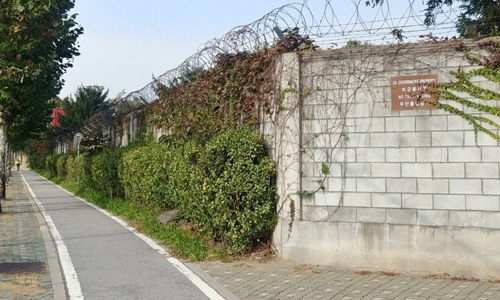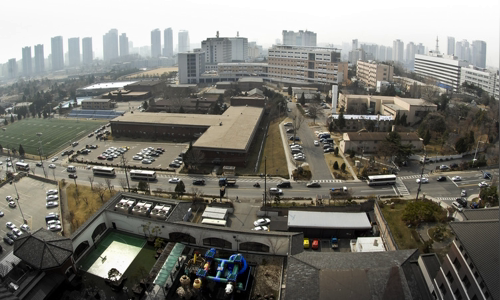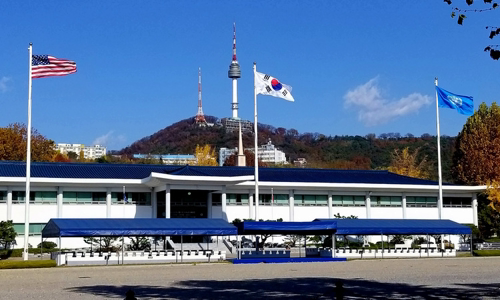South Korea: Yongsan is a land in central Seoul, but has not been under Korean control for nearly 70 years.
Yongsan Military Base is isolated from the outside world by high walls and barbed wire fences, always a thorn in the eyes of many Seoulites and tourists.

Part of the wall surrounding Yongsan base Photo: SCMP
"You have the Great Wall in China, and we have a long concrete wall in the center of the capital," Kim Hong-ryeol, a Seoul city official, said of the 13-kilometer wall surrounding the site. 2.4 square kilometers of Yongsan base.
Yongsan began to be under foreign control in 1882, when the Qing army supported the local government to suppress an uprising by those who opposed Westernization policy. Chinese forces were stationed in Yongsan, then still a village on the outskirts of Seoul.
Qing soldiers later withdrew, but returned in 1894 to quell the local peasant rebellion and lead to war with Japan to gain control of the Korean Peninsula. China failed, losing its influence for hundreds of years in the region and paving the way for the period of Japanese colonial rule in 1910-1945.
The US military captured Yongsan base from Japan after World War II and just started the process of relocating to the Humphreys base 60 km away.
Washington is deploying 28,500 soldiers in South Korean territory to deal with the threat from Pyongyang. Yongsan is considered the headquarters of this force but is also a shame to Korea, the only country in the world with foreign troops stationed in the heart of the capital.
North Korea regularly places Yongsan in propaganda campaigns, considering it an indication that Korea is part of the US colony.
Since the end of the Korean War in 1953, Seoul's urban areas have gradually expanded and encompassed Yongsan. The South Korean government always wanted to regain control of the area, but it was not until 1990 that South Korean President Roh-Tae-woo, a former conservative and pro-American military general, introduced it. proposed relocation of the US base.

A corner of Yongsan base Photo: US Army
After years of negotiations, Washington and Seoul reached a consensus in 2003, in which US forces will concentrate in two areas including Pyeongtaek in central Korea and Daegu in the south. However, the base relocation project in Yongsan only started in 2017 due to the delay in preparing accommodation for thousands of American soldiers and relatives.
"We have spent six generations of presidents since the proposed relocation, the project has been continuously stalled," Kim Hong-ryeol added.
South Korean President Moon Jae-in last year asked local authorities to take action to let people see the progress of relocation. Seoul city officials persuaded the US military to hold limited bus trips through a portion of Yongsan base.
When this activity started in November 2018, only one bus carrying 35 people a week was allowed to enter Yongsan. This number then increases to twice a week.
Visitors board the bus at Kim base, a resting place for American soldiers near Yongsan. They may leave the car at a number of locations under the supervision of a guide. "It's more like a self-sufficient village than a military base," guide Um Jin-hee describes Yongsan.
Yongsan Base is divided into two areas: Main Post (main base) in the north and South Post in the south, the two sides separated by Itaewon-ro.
During the visit, visitors can see dark brick buildings dating back to the Imperial Japanese period, as well as residential areas, schools, restaurants, post offices, and sports facilities built by the United States.

CFC headquarters building at Yongsan base Photo: US Army
Old Japanese barracks and military prisons are surrounded by nearly five-meter-high red brick walls reinforced with concrete. Many bullet wounds and damage from the Korean War are still visible from the bus. The most modern building is the building of the United States - South Korea Joint Forces Command (CFC) building built in 1978 to strengthen the alliance between the two countries, to deal with the threat of North Korea.
Seoul and Washington aim to completely relocate their CFC headquarters from Seoul by 2021. Humphreys is expected to be home to 45,000 people a year later.
Yongsan's population is now only 4,000 compared to 25,000 at its peak. The last major unit will leave when the US military opens its new hospital in Humphreys in the next few months. Yongsan Base will be turned into a park like Central Park in New York City, USA.
South Korea has spent US $ 10.8 billion to build a giant US barracks in Pyeongtaek. This is considered the largest overseas US base, occupying an area of 15 square kilometers. Washington plans to return 178 square kilometers of land to Seoul by closing 91 bases across South Korea, gathering forces in two complexes in Pyeongtaek and Daegu.
The move will end the nearly 70-year presence of US troops in the heart of South Korea's capital, Seoul. "I have mixed feelings. We have not been able to enter this forbidden land for more than 100 years, even though it was part of Korean territory," said Lee Seong-nam, a visitor at Yongsan Base.
"I feel sad when I stand here. It is at the center of a stormy period in history, having witnessed many wars and the hardships of the Korean Peninsula people at the hands of foreign troops. I also see I'm glad this place will become a park, "Mr. Lee added.



 YhumieArevaloChavez
YhumieArevaloChavez







